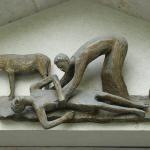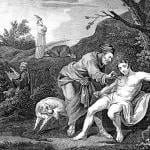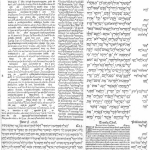Remember this story from the NY Times which suggested that the uncovering of David’s Palace was little more than a rigging funded by “conservatives” and a Jew suspected of having an agenda? (You know – the Jews-have-rights-to-Jerusalem agenda?)
And remember how the Times went out of its way to minimize the discovery, fomenting doubt before it even got to the story, and then quoting only scholars who maintained that ancient Jerusalem was really nothing to write home about?
Archaeologists debate “to what extent Jerusalem was an important city or even a city in the time of David and Samuel,” he said. “Some believe it was tiny and the kingdom unimportant.” The site of ancient Jerusalem, stuck between two valleys on a ridge south of the Temple Mount, is very small, less than 10 acres.
Israel Finkelstein, another renowned archaeologist, has suggested that without significant evidence, Jerusalem in this period was “perhaps not more than a typical hill-country village.”
In his book, “The Bible Unearthed,” Mr. Finkelstein writes with Neil Silberman, “Not only was any sign of monumental architecture missing, but so were even simple pottery shards.”
Sigh…you see, Jerusalem wasn’t impressive at all, and even if it was, there is no proof that the Jews had any sort of historical primacy within it – cough-cough-baloneyPalistinianSympathizers -cough-cough.
Well, it seems that last year, around Christmastime, the Pool of Siloam was discovered.
It was a busy time of year – maybe that’s why we all missed seeing the reports about it. But it’s a big find, and kudos to MSNBC online for filing the report.
The Pool of Siloam was uncovered last week by chance at the southern end of the City of David – in what today is Silwan – while the city was carrying out infrastructure work for a new sewage pipe.
Archeologist Eli Shukrun said that two millennia ago, Jewish residents would use the pool to gather water for their homes, as a meeting place, and also possibly as a mikve.
…
“This is our history and it is important that we know and remember that Jews lived here, and that this is our inheritance,” Education Minister Limor Livnat said.
Biblical writings indicate the pool was used by Jews for ritual immersions from about 50 B.C. to A.D. 70, when the Romans destroyed the Jewish Temple.
What is interesting is that this report reveals that ancient Jerusalem was much bigger than the NY Times’ expert suggested – and that far from being an insignificant little piece of land, it was a real home and holy city for the Jews, for the Pool of Siloam was “old” when Jesus would visit it – and it connected to the Temple Mount.
“The moment that we revealed and discovered this four months ago, we were 100 percent sure it was the Siloam Pool,” said Eli Shukron, one of the archeologists on the dig.” We know today that the Siloam Pool is connected to the Temple Mount. There is a road that connects between the two elements. The entire system is more clear today,” Shukron said.
The archaeologists excavating the site are with the Israeli government’s Antiquities Authority. They found biblical-era coins marked with ancient Jewish writing, along with pieces of broken pottery _ including a stone bottle cork _ helping them confirm that the area was the biblical Siloam Pool.
Jesus, according to the New Testament, put clay on a blind man’s eyes and then sent him to wash them out in the pool’s purifying waters, giving him sight.
Jews, who traditionally made three pilgrimages a year to Jerusalem, would immerse themselves in the Siloam Pool before heading down the stone pathway to the Temple. They also used the pool for watering purposes and camped around it.
“Jesus was a pilgrim in Jerusalem … so this would be a natural place for him to be … enjoying the water supply,” Reich said.
Many of Jesus’ acts are directly linked to Jewish rituals, and the miracle of the blind man is an example. The man was undergoing ritual immersion in the Siloam Pool for entry into the Temple compound, and Jesus used the occasion to cure his blindness (John 9: 1-7).
The Israeli Antiquities Authority is negotiating with the Greek Orthodox Church, which owns the land, to continue the dig.
“Here we can judge and see how large it is _ the grandeur of the city in those days,” Reich said.
It would seem that some – those who contend that the Jews have no right to Israel, and their supporters – would be most seriously displeased should the grandeur, and evident Jewishness, of Jerusalem be finally, fully…forensically…confirmed.
UPDATE: Another article, with some exciting additional info
“Scholars have said that there wasn’t a Pool of Siloam and that John was using a religious conceit” to illustrate a point, said New Testament scholar James H. Charlesworth of the Princeton Theological Seminary. “Now we have found the Pool of Siloam … exactly where John said it was.”
A gospel that was thought to be “pure theology is now shown to be grounded in history,” he said.
…
When ancient workmen were plastering the steps before facing them with stones, they either accidentally or deliberately buried four coins in the plaster. All four are coins of Alexander Jannaeus, a Jewish king who ruled Jerusalem from 103 to 76 BC. That provides the earliest date at which the pool could have been constructed.
Similarly, in the soil in one corner of the pool, they found about a dozen coins dating from the period of the First Jewish Revolt against Rome, which lasted from AD 66 to 70. That indicates the pool had begun to be filled in by that time.
UPDATE: Barry Rubin has some thoughts on the discovery of King David’s Palace and the manner in which it is being reported, also.
WELCOME: Thomas Lifson, American Thinker readers! I’m honored! While you’re here, please look around. In the last few days we’ve been discussing Irony at the New York Times, whether suffering is playing a role in the strange utterings of Mrs. Sheehan, and just how doable our endeavor in Iraq really is. And why it is so important.











